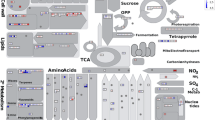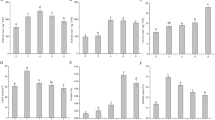Abstract
Petroleum hydrocarbons (PHC) in soil are potentially toxic to plants and exert negative effect on the environment and human health. To understand the effect of PHC on the gene expression profile of a wetland plant Spartina alterniflora in the coastal Louisiana, plants were subject up to 40% PHC under greenhouse conditions. The plants exposed to PHC showed 21% reduction of leaf total chlorophyll after 2 weeks of stress. Using 20 annealing control primers, 28 differentially expressing genes (DEGs) were identified in leaf and root tissues of S. alterniflora in response to PHC stress. Eleven of these 28 DEGs had role in either molecular function (chlorophyll a-b binding protein, HSP70, NADH, RAN1-binding protein, and RNA-binding protein), biological processes (cell wall protein, nucelosome/chromatin assembly factor) or cellular function (30 S ribosomal protein). This indicated that genes in different regulatory pathways of S. alterniflora were involved in response to PHC. All DEGs showed reduced transcript accumulation in root under oil stress, whereas they showed up- or down-regulation in their transcript abundance in leaf depending on the concentration of the PHC. The genes identified through this study could be used in the genetic screen of S. alterniflora for resistance to PHC.




Similar content being viewed by others
References
Holt, S., Rabalais, N., Rabalais, S., Cornelius, S., & Holland, J. S. (1978). Effects of an oil spill on salt marshes at Harbor Island, Texas. I. Biology. In The proceedings of the conference on assessment of ecological impacts of oil spills (pp. 344–352). Arlington, Virginia: American Institute of Biological Sciences.
DeLaune, R. D., Patrick, W. H., & Buresh, R. J. (1979). The effect of crude oil on a Louisiana Spartina alterniflora salt marsh. Environmental Pollution, 20, 21–31.
Lee, R. F., Dornseif, B., Gonsoulin, F., Tenore, K., Hanson, R., & Blanton, J. (1980). Fate and effects of oil on Georgia coastal waters and marshes. In Technical report series. No. 80–7. Skidaway Island, GA: Georgia Marine Science Center.
Smith, C. J., DeLaune, R. D., Patrick, W. H., & Fleeger, J. W. (1984). Impact of dispersed and undispersed oil entering a Gulf coast salt marsh. Environmental Toxicology and Chemistry, 3, 609–616.
Mendelssohn, I. A., Hester, M. W., Sasser, C., & Fischel, M. (1990). The effect of a Louisiana crude oil discharge from a pipeline break on the vegetation of a south-east Louisiana brackish marsh. Oil and Chemical Pollution, 7, 1–15.
Mendelssohn, I. A., Hester, M. W., & Hill, J. M. (1993). Assessing the recovery of coastal wetlands from oil spills. In Proceedings of 1993 international oil spill conference (pp. 141–145). Washington, DC: American Petroleum Institute.
Pezeshki, S. R., & DeLaune, R. D. (1993). Effect of crude oil on gas exchange functions of Juncus roemerianus and Spartina alterniflora. Water, Air, Soil and Pollution, 68, 461–468.
Baker, J. M. (1970). The effects of oil on plants. Environmental Pollution, 1, 27–44.
Alexander, S. K., & Webb Jr., J. W. (1985b). Seasonal response of Spartina alterniflora to oil. In Proceedings of 1985 oil spill conference (pp. 355–357). Washington, DC: American Petroleum Institute.
Pezeshki, S. R., Hester, M. W., Lin, Q., & Nyman, J. A. (2000). The effects of oil spill and clean-up on dominant US Gulf coast marsh macrophytes: a review. Environmental Pollution, 108, 129–139.
Lin, Q., Mendelssohn, I. A., Suidan, M. T., Lee, K., & Venosa, A. D. (2002). The dose–response relationship between No. 2 fuel oil and the growth of the salt marsh grass, Spartina alterniflora. Marine Pollution Bulletin, 44, 897–902.
McGill, W. B., Rowell, M. J., & Westlake, D. W. S. (1981). Biochemistry, ecology, and microbiology of petroleum components in soil. In E. A. Paul & J. N. Ladd (Eds.), Soil biochemistry, Vol. 5 (pp. 229–296). NY: Marcel Dekker.
Scholten, M. C., & Leendertse, P. C. Th. (1991). Impact oil spill on salt marsh vegetation. In J. Rozema & J. A. C. Verkleiji (Eds.), Ecological responses to environmental stress (pp. 184–190). Dordrecht, Netherlands: Kluwer.
Ranwell, D. S. (1968). Extent of damage to coastal habitats due to the Torrey Canyon incident. In The biological effects of oil pollution in littoral communities (pp. 39–47). London: Field Studies Council.
Cowell, E. B. (1969). The effects of oil pollution on salt-marsh communities in Pembroke shire and Cornwall. Journal of Applied Ecology, 6, 133–142.
Rentz, J. A., Chapman, B., Alvarez, P. J. J., & Schnoor, J. L. (2003). Stimulation of hybrid poplar growth in petroleum-contaminated soils through oxygen addition and soil nutrient amendments. International Journal of Phytoremdiation, 5, 57–72.
Alexander, S. K., & Webb Jr., J. W. (1985a). Oil in the salt marsh: what have we learned? In C. F. Bryan, P. J. Zwank, & R. H. Chabreck (Eds.), Proceedings of fourth coastal marsh and estuary management symposium (pp. 49–62). Baton Rouge: Louisiana State University.
Lin, Q., & Mendelssohn, I. A. (1996). A comparative investigation of the effects of South Louisiana Crude oil on the vegetation of fresh, brackish, and salt marshes. Marine Pollution Bulletin, 32, 202–209.
Lin, Q., & Mendelssohn, I. A. (1998). The combined effects of phytoremediation and biostimulation in enhancing habitat restoration and oil degradation of petroleum contaminated wetlands. Ecological Engineering, 10, 263–274.
Lin, Q., Mendelssohn, I. A., Henry, C. B., Hester, M. W., & Webb, E. C. (1999). Effects of oil cleanup methods on ecological recovery and oil degradation of Phragmites marshes. In Proceedings of the 1999 international oil spill conference (pp. 511–517). Washington, DC: American Petroleum Institute.
Ryan, A. B., Venuto, B. C., Subudhi, P. K., Harrison, S. A., Shadow, R. A., Fang, X., et al. (2007). Identification and genetic characterization of smooth cordgrass for coastal wetland restoration. Journal of Aquatic Plant Management, 45, 90–99.
Utomo, H. S., Wenefrida, I., Materne, M., & Harrison, S. H. (2008). Genetic diversity and population genetic structure of salt marsh Spartina alterniflora from four coastal Louisiana basins. Aquatic Botany, 90, 30–36.
Baisakh, N., Subudhi, P. K., Arumuganathan, K., Parco, A. P., Harrison, S., Knott, C. A., et al. (2009). Development and interspecific transferability of genic microsatellite markers in Spartina spp with different genome size. Aquatic Botany, 91, 262–266.
Subudhi, P. K., & Baisakh, N. (2011). Spartina alterniflora Loisel, a halophyte grass model to dissect salt stress tolerance. In vitro Cellular and Developmental Biology–Plant. doi:10.1007/s11627-011-9361-8.
Baisakh, N., Subudhi, P. K., & Parami, N. (2006). cDNA-AFLP analysis reveals differential gene expression in response to salt stress in a halophyte Spartina alterniflora Loisel. Plant Science, 17, 1141–1149.
Baisakh, N., Subudhi, P. K., & Hardwar, P. (2008). Primary responses to salt stress in a halophyte smooth cordgrass (Spartina alterniflora Loisel.). Functional and Integrative Genomics, 8, 287–300.
Baisakh, N., & Subudhi, P. K. (2009). Heat stress alters the expression of salt stress induced genes in smooth cordgrass (Spartina alterniflora L). Plant Physiology and Biochemistry, 47, 232–235.
Jayaraman, A., Puranik, S., Rai, N. K., Vidapu, S., Sahu, P. P., Lata, C., et al. (2008). cDNA-AFLP analysis reveals differential gene expression in response to salt stress in foxtail millet (Setaria italica L.). Molecular Biotechnology, 40, 241–251.
Kim, Y. J., Kwak, C. I., Gu, Y. Y., Hwang, I. T., & Chun, J. Y. (2004). Annealing control primer system for identification of differentially expressed genes on agarose gels. Biotechniques, 36, 424–434.
García-Gomez, B. I., Campos, F., Hernández, M., & Covarrubias, A. A. (2000). Two bean cell wall proteins more abundant during water deficit are high in proline and interact with a plasma membrane protein. Plant Journal, 22, 277–288.
Murphy, A. S., Hoogner, K. R., Peer, W. A., & Taiz, L. (2002). Identification, purification, and molecular cloning of N-1-naphthylphtalmic acid-binding plasma membrane-associated amino peptidases from Arabidopsis. Plant Physiology, 128, 935–950.
Creelman, R. A., & Mullet, J. E. (1991). Water deficit modulates gene expression in growing zones of soybean seedlings. Analysis of differentially expressed cDNAs, a new beta-tubulin gene, and expression of genes encoding cell wall proteins. Plant Molecular Biology, 17, 591–608.
Colmenero-Flores, J. M., Campos, F., Graciarrubio, A., & Covarrubias, A. A. (1997). Characterization of Phaseolus vulgaris cDNA clones responsive to water deficit: Identification of a novel late embryogenesis abundant-like protein. Plant Molecular Biology, 35, 393–405.
Deutch, C. E., & Winicov, I. (1995). Post-transcriptional regulation of a salt-inducible alfalfa gene encoding a putative chimeric proline-rich cell wall protein. Plant Molecular Biology, 27, 411–418.
Showalter, A. M. (1993). Structure and function of plant cell wall proteins. Plant Cell, 5, 9–23.
Li, X., Feng, Y., & Sawatsky, N. (1997). Importance of soil–water relations in assessing the endpoint of bioremediated soils. Plant and Soil, 192, 219–226.
Ciciarello, M., Mangiacasale, R., & Lavia, P. (2007). Spatial control of mitosis by the GTPase Ran. Cellular and Molecular Life Sciences, 64, 1891–1914.
Dasso, M. (2001). Running on Ran: nuclear transport and the mitotic spindle. Cell, 104, 321–324.
Kim, S. H., Arnold, D., Lloyd, A., & Roux, S. J. (2001). Antisense expression of an Arabidopsis Ran binding protein renders transgenic roots hypersensitive to auxin and alters auxin-induced root growth and development by arresting mitotic progress. The Plant Cell, 13, 2619–2630.
Cho, H. Y., Park, J. A., & Pai, H. S. (2008). Physiological function of NbRanBP1 in Nicotiana benthamiana. Molecules and Cells, 26, 270–277.
Udo, E. J., & Fayemi, A. A. A. (1975). The effect of oil pollution of soil on germination, growth and nutrient uptake of corn. Journal of Environmental Quality, 4, 537–540.
Chaîneau, C. H., Morel, J. L., & Oudot, J. (1997). Phytotoxicity and plant uptake of fuel oil hydrocarbons. Journal of Environmental Quality, 26, 1478–1483.
Rentz, J. A., Chapman, B., Alvarez, P. J. J., & Schnoor, J. L. (2003). Stimulation of hybrid poplar growth in petroleum-contaminated soils through oxygen addition and soil nutrient amendments. International Journal of Phytoremediation, 5, 57–72.
Krude, T. (1999). Chromatin assembly during DNA replication in somatic cells. European Journal of Biochemistry, 263, 1–5.
Ridgway, P., & Almouzni, G. (2001). Chromatin assembly and organization. Journal of Cell Science, 114, 2711–2712.
Green, C. M., & Almouzni, G. (2002). When repair meets chromatin-First in series on chromatin dynamics. European Molecular Biology Organisation Reports, 3, 28–33.
Maser, R. S., & DePinho, R. A. (2002). Connecting chromosomes, crisis, and cancer. Science, 297, 565–569.
Haushalter, K. A., & Kadonaga, J. T. (2003). Chromatin assembly by DNA-trans locating motors. Nature Reviews. Molecular Cell Biology, 4, 613–620.
Castro, J. M. P., Figueroa, B. E. B., Linares, L. F., Medrano, R. R., & Cazares, B. X. (2006). Isolation and identification of up-regulated genes in bermundagrass roots (Cynodon dactylon L.) grown under petroleum hydrocarbon stress. Plant Science, 170, 724–731.
Dreyfuss, G., Matunis, M. J., Pinol-Roma, S., & Burd, C. G. (1993). HnRNP proteins and the biogenesis of mRNA. Annual Review of Biochemistry, 62, 289–321.
Simpson, G. G., & Filipowicz, W. (1996). Splicing of precursors to mRNA in higher plants: mechanism, regulation and sub-nuclear organization of the spliceosomal machinery. Plant Molecular Biology, 32, 1–41.
Kim, J. S., Jung, H. J., Lee, H. J., Kim, K. A., Goh, C. H., Woo, Y., et al. (2008). Glycine-rich RNA-binding protein7 affects abiotic stress responses by regulating stomata opening and closing in Arabidopsis thaliana. The Plant Journal, 55, 455–466.
Kim, J. Y., Park, S. J., Jang, B., Jung, C. H., Ahn, S. J., Goh, C. H., et al. (2007). Functional characterization of a glycine-rich RNA-binding protein2 in Arabidopsis thaliana under abiotic stress conditions. The Plant Journal, 50, 39–451.
Kim, Y. O., Kim, J. S., & Kang, H. (2005). Cold-inducible zinc finger-containing glycine-rich RNA-binding protein contributes to the enhancement of freezing tolerance in Arabidopsis thaliana. The Plant Journal, 42, 890–900.
Sachetto-Martins, G., Franco, L. O., & Oliveira, D. E. (2000). Plant glycine-rich proteins: a family or just proteins with a common motif? Biochimica et Biophysica Acta, 1492, 1–14.
Acknowledgments
The financial support from USDA-CSREES for this study is gratefully acknowledged. This manuscript is approved for publication by the Director of Louisiana Agricultural Experiment Station as manuscript #2011-306-6272.
Author information
Authors and Affiliations
Corresponding author
Rights and permissions
About this article
Cite this article
RamanaRao, M.V., Weindorf, D., Breitenbeck, G. et al. Differential Expression of the Transcripts of Spartina alterniflora Loisel (Smooth Cordgrass) Induced in Response to Petroleum Hydrocarbon. Mol Biotechnol 51, 18–26 (2012). https://doi.org/10.1007/s12033-011-9436-0
Published:
Issue Date:
DOI: https://doi.org/10.1007/s12033-011-9436-0




